Original URL: https://www.theregister.com/2014/06/25/volkswagen_eup/
Gid E-Up? Vulture's claw presses pedal to metal on VW's 'leccy motor
Starts with a jolt
Posted in Personal Tech, 25th June 2014 09:03 GMT
After the driving the Citroen C-Zero, the Volkswagen e-Up! is a fantastically different experience.
It shouldn’t be quite so much better, as the VW is cheaper (£19,704 as opposed to £21,216 – both prices including rebates) yet while the Citroen is clearly engineered to a price – albeit a typically electric twice the internal combustion engine equivalent – the e-Up! (we'll dispense with the irritating exclamation mark here and now before the sub-editor has an aneurysm) has a Germanic feel of solidity.

We reviewed the original petrol-powered Up! some while ago and found it to be a rather nice small car. The e-Up is the first electric car I’ve driven which does not appear to have creep engineered in. Most others start to roll forward like a torque-converter-based automatic when you take your foot off the brake. This takes the edge off the acceleration.
The e-Up really does give all the torque from standstill and that makes for an entertaining party trick. You can set a Tesla S up to do the same as creep is a menu option on that, but then you could buy four e-Ups for the price of a typically specified Tesla S.
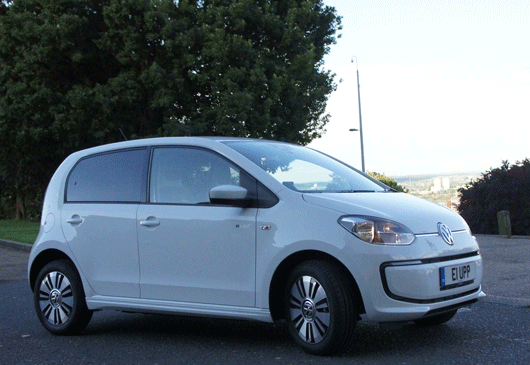
But starting with a jolt isn’t the only reason the e-Up is fun to drive. It corners pretty flat thanks to the weight distribution and of course has the spooky silence of an electric car. While I love the roar of a V8 or scream of a V12 I also enjoy the sci-fi silence of electric.
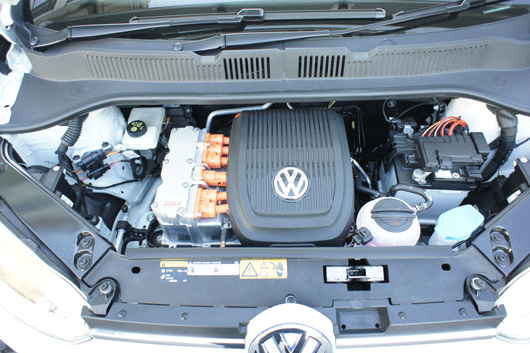
So there is a substitute for cubes
It may only have a 60kW (81bhp in old money) motor sitting in the traditional space under the bonnet and driving the front wheels, but with a 210Nm (155lb ft) and all the battery weight low down between the axles, it’s a nippy little thing despite tipping the scales at 1,139kg – of which 230kg is batteries. The 0-62mph (100kmph) stat of 12.4 seconds and top speed of 81mph (130kmph) sound pedestrian but really aren’t. That engine is more powerful than either of the options in the petrol engine version, and the acceleration 0.8 of a second quicker to 62, although top speed is down on the petrol-burner – which may be a way of keeping the reins on the range.
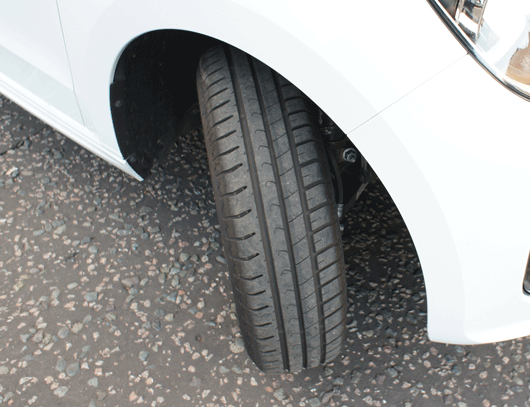
With the car weighing 1.1 tonnes and lots of torque you can expect to buy quite a lot of these
With that much power through the front wheels via a single-speed gearbox I would have expected some torque steer but, perhaps because the wheels are narrow, there wasn’t any. And it seems to be electronically managed to prevent any boy-racer tyre squealing. I generally don’t like assisted steering and particularly not electrically assisted – which has become the norm and which is what the e-Up uses – but the feel is reasonably good.

VW's new baby... Remember when the Golf was the 'littlest' car?
The nippiness is helped by its short wheelbase. The e-Up is only 3.5m long with very short overhangs. The front suspension uses struts with wishbones. A key component here is the sub-frame to which the single-pressing transverse link is mounted and which accepts loads from the anti-roll bar. The sub-frame is integral with the upper spring mounting and also carries the steering unit and the engine mountings.
At the back there is a torsion beam rear axle with the semi-independent suspension to keep the weight down. As for brakes, there are discs at the front, drums at the rear with ABS and electronic stability control. Like the petrol Up, there is a city emergency braking system which works at speeds below 19mph and uses a laser sensor just below the windscreen to scan for things you might hit and slams on the anchors if necessary.
Once upon a time the Golf was the small VW, but cars, like waistlines, grow with age and the small car ranges are the Lupo, Fox and now the Up – with the latter the cute little one.
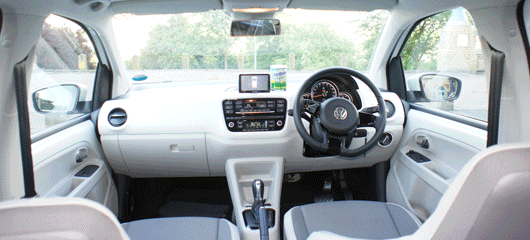
Inside there is a surprising amount of space for such a small car. The bootspace is good, with a strange two-level boot so that you store the charging gubbins below your shopping, but there was still plenty of space for two hundred quid’s worth of Tesco’s fodder.
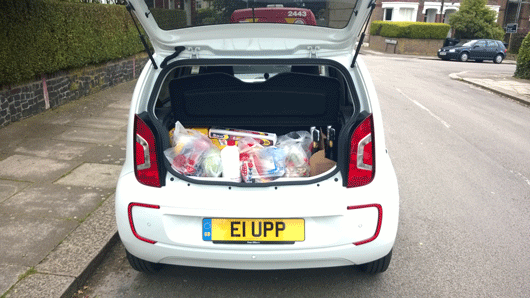
The e-Up is a five-door model and has odd back windows that only open on a catch and don’t wind down. This isn’t unusual on three-door cars but it’s the first time I’ve seen it on opening doors.
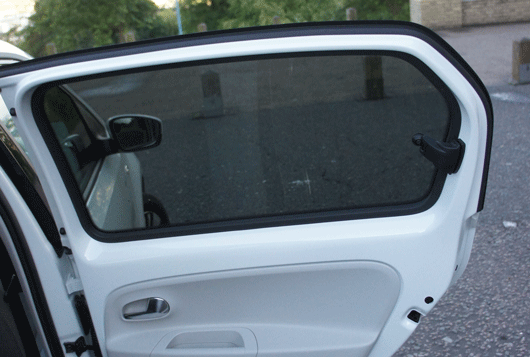
The rear doors are too small for the window to wind down into them
And you do open the doors because the car is so nice you want to take people to places in it. Fit and finish is good and the cabin bright with good sight lines.
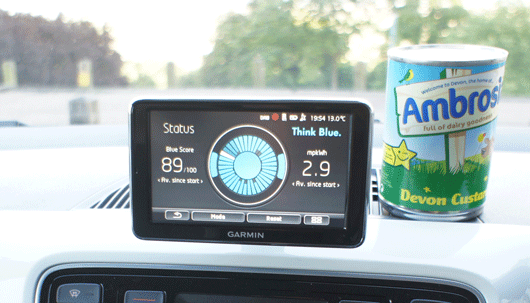
Plumb in the middle of the dashboard is the removable display which serves as a control for the phone Bluetooth, the multimedia system, sat nav and is your route to vast amounts of information on power saving and consumption. You can configure the power consumption and generation in a huge number of ways. The display is good, but the touch control, which I take to be resistive rather than capacitive, is poor. It was slow to take in information and I often got double and triple letters when I wanted one.

You can tell the audio where to position the sweet spot for the music
Drive, price and value
There are two economy profiles: "Eco" and "Eco+". The range can be varied via three different driving style profiles: the standard mode which is automatically on, "Eco" and "Eco+".
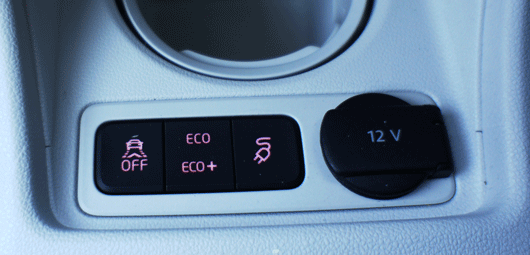
Reins in speed, torque and air-con.
Eco mode drops the maximum power to 50kW, reduces the output of the air-conditioning system and modifies the response curve of the accelerator pedal. In Eco+ the electronics limit maximum power output to 40kW, further tames the performance response curve – reducing pull-away torque – and disables the air conditioning. In the "Eco" and "Eco+" modes, the top speed is drops to 71mph and 56mph (114kmph and 90kmph) respectively. There seemed to be a difference in how the modes affected the air-con: if it was already on when you selected Eco+, it stayed on, but if air-con was off and then you switched to Eco+ you couldn’t then switch the air-conditioning on.
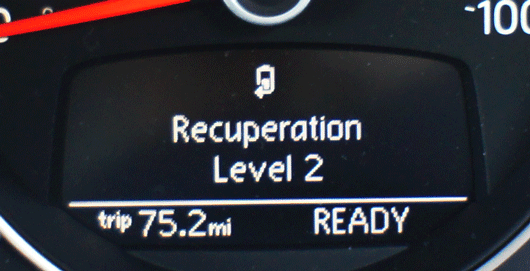
The little VW supports five different flavours of regenerative braking all accessed through the gear lever: D, D1, D2, D3 and B. In D, the generator only harnesses power when you brake. In the others there is increasing regeneration when you are slowing. At levels D2, D3 and B, the deceleration via regenerative braking is so strong the brake lights automatically come on. Driving down the steep hill of Alexandra Place in D3, the retardation was so great I had to accelerate to overcome it. If the battery is fully charged, no regenerative braking occurs.
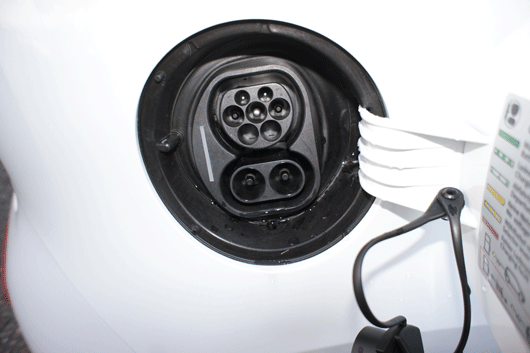
But regenerative only gets you so far until you need to plug the e-Up in. The simplest option is to plug the mains charging cable supplied with the car into a conventional 230-volt socket. The battery is then charged from the mains at a power level of 2.3 kW. If completely flat, it is fully recharged in this way within around nine hours. You can also get a wall box. British Gas will fit one for free. At 3.6 kW, a completely flat battery can be 100 per cent recharged in six hours. The e-Up has a port for the combined charging system (CCS) using a DC power supply, which – if there were any - charges the car to 80 per cent in 30 minutes.
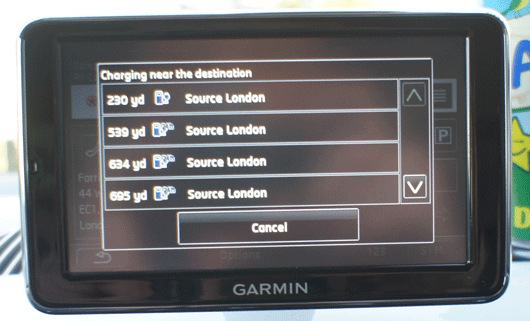
The detailed range display is built into the mapping system showing you where you can get to with the current state of charge and usage. It also has Source London and other charging points as points of interest with the ability to add your own.
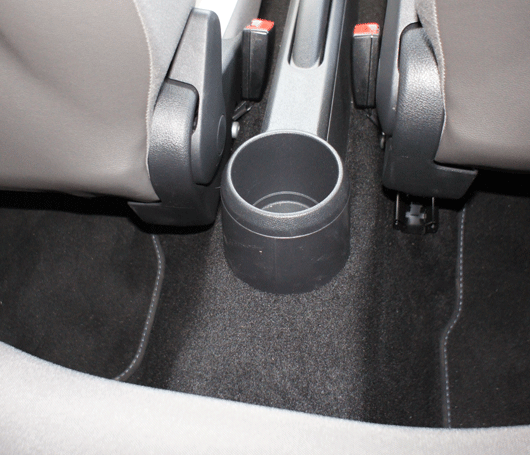
The rear passengers get to share a cupholder
The display has some neat graphics showing power flow and an e-manager which, as in the Leaf and Tesla S, lets you program the charge start time and set the heating or cooling while the car is still sucking juice from the mains so that it doesn’t have to use battery power once you leave. You can set this for up to 30 minutes when plugged in and 10 minutes when not connected. This can all be controlled from an iPhone or Android app. The online service is however chargeable, with the three years included.
The biggest concern is the battery life, so while the car gets a two-year warranty, the battery is guaranteed for eight years or 100,000 miles (161,000km).
The thing about electric cars however is that when someone says “What’ll it do, mister?”, they don’t mean top speed. It’s all about range. VW claims 93 miles (150km) between charges, which in use seemed to be realistic, but there is a difference between believing the figures when you still have a spare 30 or 40 miles and relying on them to do a journey of 60 miles.
It may be something where your confidence grows with experience, especially since the display gives detailed breakdowns of consumption and distance in kW. You need to be technically savvy and interested but all the information is there. However in a week with E1 UPP I wasn’t prepared to chance a round trip of 50 miles from North London to Luton airport.
One of the surprising things about the e-Up is that it’s a Volkswagen and not an Audi. VAG, or Volkswagen Aktiengesellschaft, includes everything from Skoda to Bugatti. The group usually tries things out on Audi – the experimental brand. Audi was the first with all aluminium on the A2, the DSG gearbox on the TT and most significantly performance four-wheel drive with the Ur-Quattro. That the first electric car should be wearing a VW badge is a departure.
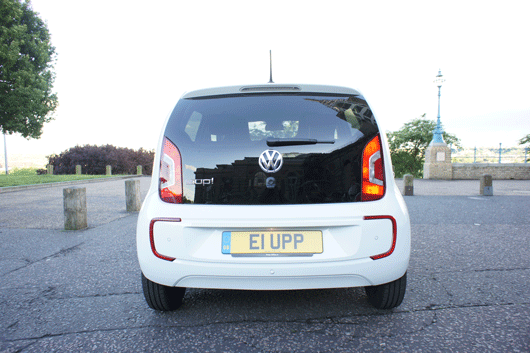
As ever, the maths has to come into play when you make that purchase decision. There is the all-but-free fuel, given that petrol is so horrendously taxed. There is the £5,000 the government will give you for buying one, not paying the congestion charge and there is the spotty free parking.
But the only bit that really matters is the 0 per cent benefit in kind. If you pay tax at 40 or 45 per cent, then having this as a company car is only marginally more expensive than a petrol-engined version. You have to accept that deprecation will be savage, although that eight-year battery warranty will help. At under £20k it’s good value for an electric car, but not for a small car. ®